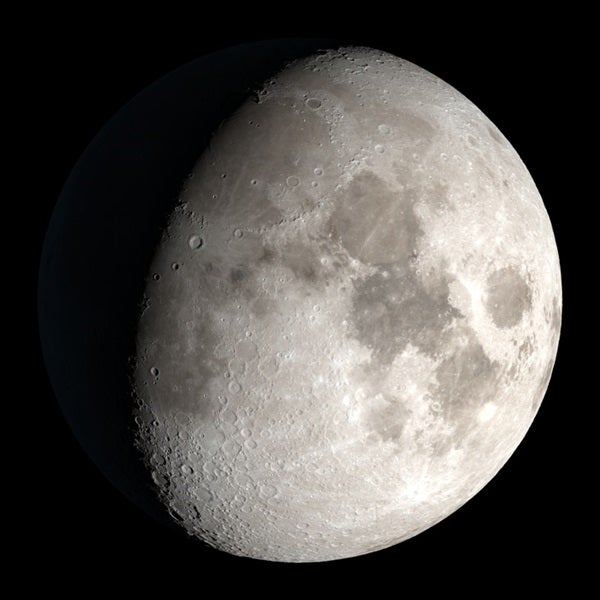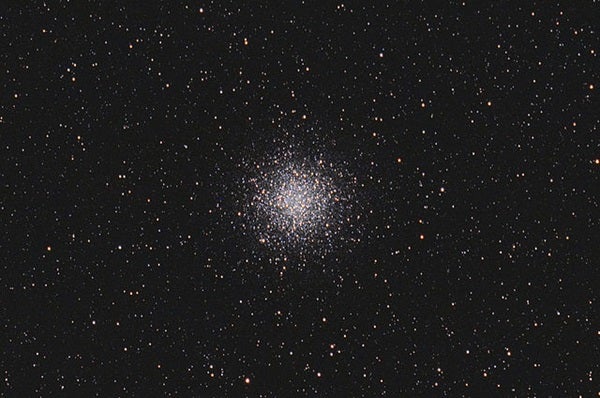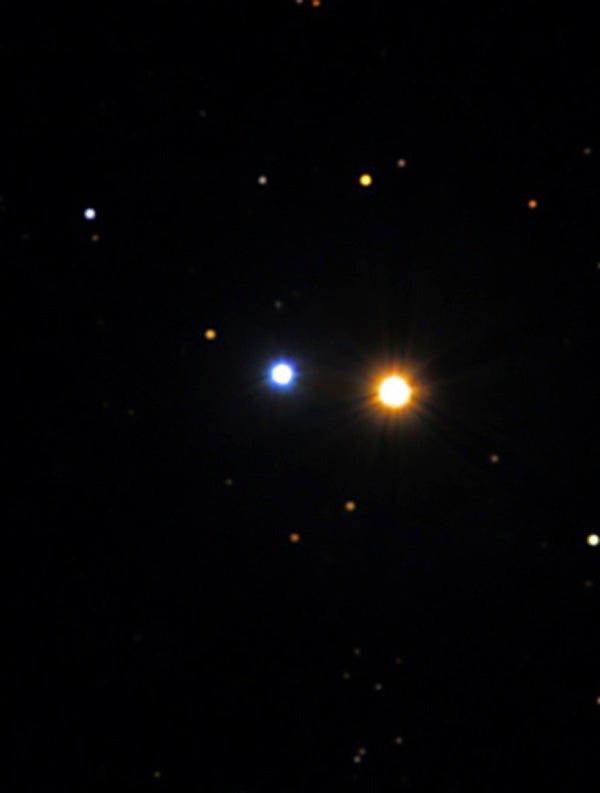The Moon passes 1.6° south of Jupiter at 3 A.M. EDT this morning; our satellite then passes 2° south of Saturn at 5 P.M. EDT. You can still see the Moon near the two giant planets after dark this evening. Look south to find the Moon, now 10° southeast of Jupiter and nearly 4° southeast of Saturn. All three are readily visible to the naked eye, but binoculars or a telescope will reveal more detail on the planets, including Saturn’s rings and the alternating colored cloud bands of Jupiter.
Jupiter’s intriguingly icy moon, Europa, begins to transit the planet’s disk from the east starting at 10:07 P.M. EDT. Its shadow slips onto the disk 2.5 hours later, just 14 minutes before the moon passes off the planet’s western limb. Europa’s shadow slowly crosses Jupiter over the next 2.5 hours, disappearing by 3:30 A.M. the morning of the 26th.
Sunrise*: 6:51 A.M.
Sunset: 6:51 P.M.
Moonrise: 3:57 P.M.
Moonset: 12:25 A.M.
Moon Phase: Waxing gibbous (67%)
*Times for sunrise, sunset, moonrise, and moonset are given in local time from 40° N 90° W. The Moon’s illumination is given at 12 P.M. local time from the same location.
Saturday, September 26
Tonight is International Observe the Moon Night. Click over to NASA’s official page at http://moon.nasa.gov/observe for more information about the event and how you can participate simply by stepping outside and looking up.
With our satellite a well-lit waxing gibbous today, much of its terrain will be on display, as well as many of the Apollo landing sites. Several maria, or seas, appear as dark splotches against the brighter surrounding terrain. These darker areas never held water but are instead ancient lava flows, left over from when our Moon was much younger. Their relatively smooth floors made them ideal targets for manned landings. Easily visible tonight are Mare Serenitas, Mare Tranquillitatis, Mare Crisium, Mare Fecunditatis, and Mare Nectaris. Just peeking out from the terminator is Mare Imbrium, bordered by the rugged Apennine mountains, named after the mountain range in Italy.
Target the Apollo landing sites with tips from Astronomy contributing editor Michael E. Bakich.
Today also marks the world premiere of the immersive, 360° planetarium show Big Astronomy: People, Places, Discoveries. The show will take you beneath the dark skies of Chile to travel behind the scenes of some of the world’s cutting-edge astronomical observatories. Viewers will explore the amazing instruments humanity has built to study the cosmos and take a peek at the stunning discoveries they’ve made.
You can catch the show at 5 P.M. and 7 P.M. PT on either the California Academy of Sciences YouTube channel or the Big Astronomy YouTube channel. There is a Spanish language showing at 2 P.M. PT. If you aren’t able to watch the show today, don’t worry — beginning September 30, Big Astronomy will run on both YouTube channels every Wednesday at 11:30 A.M. PT.
Sunrise: 6:52 A.M.
Sunset: 6:49 P.M.
Moonrise: 4:40 P.M.
Moonset: 1:26 A.M.
Moon Phase: Waxing gibbous (76%)
Sunday, September 27
With the Moon setting around 2:30 A.M., early morning is a good time to catch a glimpse of dimmer objects washed out by its light. Consider setting your sights on the Andromeda Galaxy, also cataloged as M31, which sits high in the northwestern sky after moonset. From a dark location, you may be able to spot it without optical aid — at about 2.5 million light-years, it’s one of the most distant objects visible to the naked eye. Its magnitude 3.4 glow stretches 173′ across and 63′ wide, making it appear as an oblong “fuzz” in binoculars or a telescope. Take your time once you find it — do you see how the center, or nucleus, of the galaxy is brightest and most concentrated, while the outskirts formed by its spiral arms are wispy?
If you’re up for a further challenge, consider looking for two of Andromeda’s smaller satellite galaxies: M32 and M110, south and north of M31, respectively. They are visible in binoculars but pop out much more readily in larger scopes. M32 lies close to the galaxy’s core, while M110 lies roughly 60′ from the plane.
Sunrise: 6:53 A.M.
Sunset: 6:48 P.M.
Moonrise: 5:15 P.M.
Moonset: 2:28 A.M.
Moon Phase: Waxing gibbous (84%)
Saturn will halt its westward motion, coming to an apparent stop against the background stars at 11 P.M. EDT tonight. It will now begin moving eastward again — although not as quickly as Jupiter. The largest planet in the solar system switched directions September 12 and is tracking east much faster than Saturn. Jupiter will ultimately catch up with the ringed planet December 21 for an extraordinary close conjunction that will bring Saturn (apparently) as close as Jupiter’s own moons.
Our own Moon has pulled away from Sagittarius, where the giant planets now sit, so consider spending some time in this constellation tonight. The tiny dwarf planet Pluto, currently around magnitude 14, lies roughly between Saturn and Jupiter, about 3° west-southwest of Saturn and just under 4° east-southeast of Jupiter. You’ll need at least a small scope and clear skies to see it.
Other celestial delights in Sagittarius to turn your telescope on include numerous star clusters. Open star clusters in this constellation include M18, M21, M23, and M25; globulars include M22, M28, M54, M55, and M75.
Sunrise: 6:54 A.M.
Sunset: 6:46 P.M.
Moonrise: 5:48 P.M.
Moonset: 3:31 A.M.
Moon Phase: Waxing gibbous (91%)
Tuesday, September 29
The Moon passes 4° south of Neptune at 10 P.M. EDT tonight. You can find the pair in Aquarius the Water-bearer in the southeast at that time, although you’ll need large binoculars or a small scope to catch Neptune’s nearly magnitude 8 glow, especially in the glare of our satellite.
For a planet that’s much easier to spot, look east to find magnitude –2.5 Mars about 16° above the horizon. Currently appearing about 22″ across, Mars is headed for a brilliant opposition next month you won’t want to miss.
Between Mars and Neptune on the sky is main-belt asteroid 68 Leto, which reaches opposition at 11 P.M. EDT. It’s roughly magnitude 10 — best seen with a telescope. Discovered in 1861, Leto is 76 miles (123 kilometers) across. It’s currently traveling through the constellation Cetus the Whale.
You can find yet another planet, Uranus, by looking 15° east-northeast of Mars, closer to the horizon. The nearer of our solar system’s two ice giants is magnitude 5.7 and should show up in binoculars, though beware the Moon’s nearby glow.
Sunrise: 6:55 A.M.
Sunset: 6:44 P.M.
Moonrise: 6:15 P.M.
Moonset: 4:32 A.M.
Moon Phase: Waxing gibbous (96%)
Jupiter’s moons are having a busy week: Callisto’s shadow will begin creeping onto the planet’s disk around 9:04 P.M. EDT tonight. The shadow is so large that it takes roughly 10 minutes to fully slip onto the northeastern limb. Keep your eye on the gas giant overnight and you’ll also see tiny Io reappear from eclipse about 12:03 A.M. October 1. It should spring into view roughly 22″ from the Jupiter’s eastern limb.
With a nearly Full Moon tonight, many deep-sky objects are off limits. But it’s a great time to take in one of the summer sky’s most appealing double-star sights: Albireo (Beta [β] Cygni), the head of Cygnus the Swan. Still high overhead tonight, this pair of stars offers contrasting colors of gold and blue. The magnitude 3.1 and 5.1 pair has a separation of 34″, making the two stars easy to resolve in binoculars. Use a small scope (even 2 inches will do) to really bring out their vivid colors.
Sunrise: 6:56 A.M.
Sunset: 6:43 P.M.
Moonrise: 6:39 P.M.
Moonset: 5:32 A.M.
Moon Phase: Waxing gibbous (99%)
Thursday, October 1
Mercury reaches greatest eastern elongation (26° from the Sun) at 12 P.M. EDT today. You can spot the solar system’s smallest planet this evening, but you’ll need to be quick — it’s only 3° high in the west-southwest 30 minutes after sunset, but a glowing a bright magnitude 0. The planet sets 20 minutes later. By then, some of the brightest stars should be popping out of the twilight: Arcturus, Vega, Deneb, Altair, and Fomalhaut. Jupiter and Saturn should appear about the same time.
Full Moon occurs at 5:05 P.M. EDT. Our satellite will rise in the east just moments after sunset and remain visible in the sky all night. It’s the first of two Full Moons this month — the second, called a Blue Moon when two Full phases take place in the same month, will occur October 31.
Sunrise: 6:57 A.M.
Sunset: 6:41 P.M.
Moonrise: 7: 03 P.M.
Moonset: 6:31 A.M.
Moon Phase: Full
Friday, October 2
Venus and the bright star Regulus in Leo are a mere 0.5° apart an hour before sunrise this morning. The pair rises together in the east around 4 A.M. local time, so you’ll have at least three hours to catch the sight. Earth’s sister planet glows a bright magnitude –4.1, which is about 145 times brighter than Regulus nearby. Venus’ disk currently spans about 15″; with magnification, you’ll see it’s a 72-percent-lit crescent. The planet will pass 0.09° south of Regulus at 8 P.M. EDT tonight, and they’ll be 41″ apart by 5 A.M. tomorrow morning.
The Moon passes 0.7° south of Mars at 11 P.M. EDT. At that time, the Red Planet will be on view high in the southeast. Both should be readily visible, thanks to Mars’ brilliance. The dim stars of Pisces around them, however, will likely be washed out by the Moon’s bright light.
Sunrise: 6:58 A.M.
Sunset: 6:40 P.M.
Moonrise: 7:27 P.M.
Moonset: 7:30 A.M.
Moon Phase: Waning gibbous (99%)












